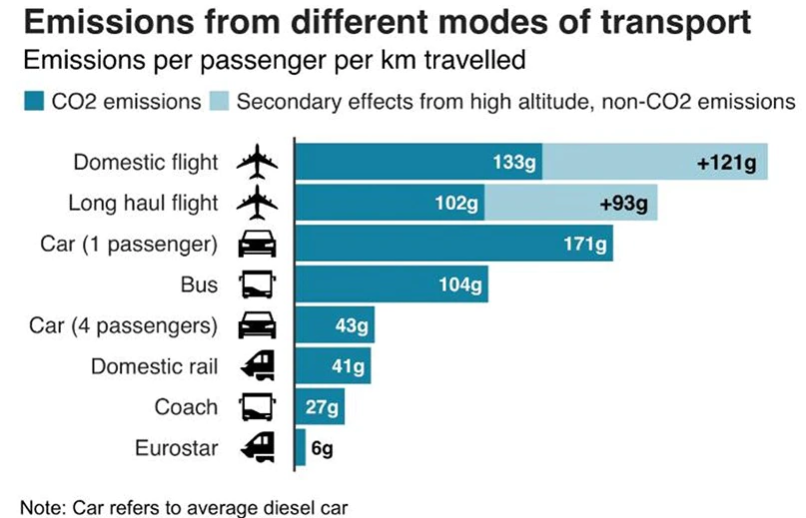What has happened?
Aircraft on routes of 700 kilometers or less emit more carbon dioxide per person for every kilometer traveled than long-haul flights: 251 grams per km for short haul compared to 195 g/km for long haul. That’s due to the fact that take-off and landing uses the most fuel, making level flight over whatever distance relatively cleaner.
By comparison, a diesel car emits 171 g/km of CO2 with one passenger, or an average of 43 g/km for four passengers, according to UK government figures. An urban bus emits 104 g/km and a coach 27 g/km due to its greater weight efficiency. Electrified domestic rail, including shorter suburban services, emits 41 g/km.
The most efficient form of transport is the transnational Eurostar, emitting only 6 g/km per passenger on trips through the Channel Tunnel. It means someone who flies from Amsterdam to London but returns on the Eurostar will be responsible for 20 times more CO2 emissions on the flight there than on the train back.

Source: BEIS/Defra Greenhouse Gas Conversion Factors 2019
Reducing carbon emissions from all sources to make the world effectively carbon-neutral by 2050 is essential to meet the goals of the Paris Agreement. This seeks to limit global warming to 2 degrees Celsius or less above pre-industrial levels.
The entire transport sector is responsible for about 14.7% of all greenhouse gases emitted. The biggest contributor is not the more CO2-intensive airline industry, responsible for about 1.7% of all CO2 emissions, but road vehicles, accounting for 10.5%.
One problem is that unlike cars, aircraft cannot be battery powered – the batteries needed to get a 200-ton aircraft off the ground would currently weigh three times as much as the plane. However, work has begun in the US in trying to develop a hybrid electric engine for a 186-seater plane, with the first test flight due in 2023.
What does it mean for investors?
“Electrification will transform all modes of mobility, transport and travel,” says Thiemo Lang, portfolio manager of the RobecoSAM Smart Mobility strategy which targets companies operating in this sector. “Though the pace of change varies by vehicle and purpose, the revolution is underway and accelerating.”
“Emissions regulations and improved economics are shaping the market, coupled with increasing urbanization and growing megacities which create demand for the sustainability of all modes of public transportation and the rise in private electric vehicles on our streets.
“For investors, this presents an opportunity to participate in the transformative shift towards zero-carbon mobility. The RobecoSAM Smart Mobility strategy focuses on companies enabling this transformation in all its forms – ground, sea, and sky – including component suppliers, electrical grid and charging suppliers, and data connectivity solutions providers.”
Important information
The contents of this document have not been reviewed by the Securities and Futures Commission ("SFC") in Hong Kong. If you are in any doubt about any of the contents of this document, you should obtain independent professional advice. This document has been distributed by Robeco Hong Kong Limited (‘Robeco’). Robeco is regulated by the SFC in Hong Kong. This document has been prepared on a confidential basis solely for the recipient and is for information purposes only. Any reproduction or distribution of this documentation, in whole or in part, or the disclosure of its contents, without the prior written consent of Robeco, is prohibited. By accepting this documentation, the recipient agrees to the foregoing This document is intended to provide the reader with information on Robeco’s specific capabilities, but does not constitute a recommendation to buy or sell certain securities or investment products. Investment decisions should only be based on the relevant prospectus and on thorough financial, fiscal and legal advice. Please refer to the relevant offering documents for details including the risk factors before making any investment decisions. The contents of this document are based upon sources of information believed to be reliable. This document is not intended for distribution to or use by any person or entity in any jurisdiction or country where such distribution or use would be contrary to local law or regulation. Investment Involves risks. Historical returns are provided for illustrative purposes only and do not necessarily reflect Robeco’s expectations for the future. The value of your investments may fluctuate. Past performance is no indication of current or future performance.
